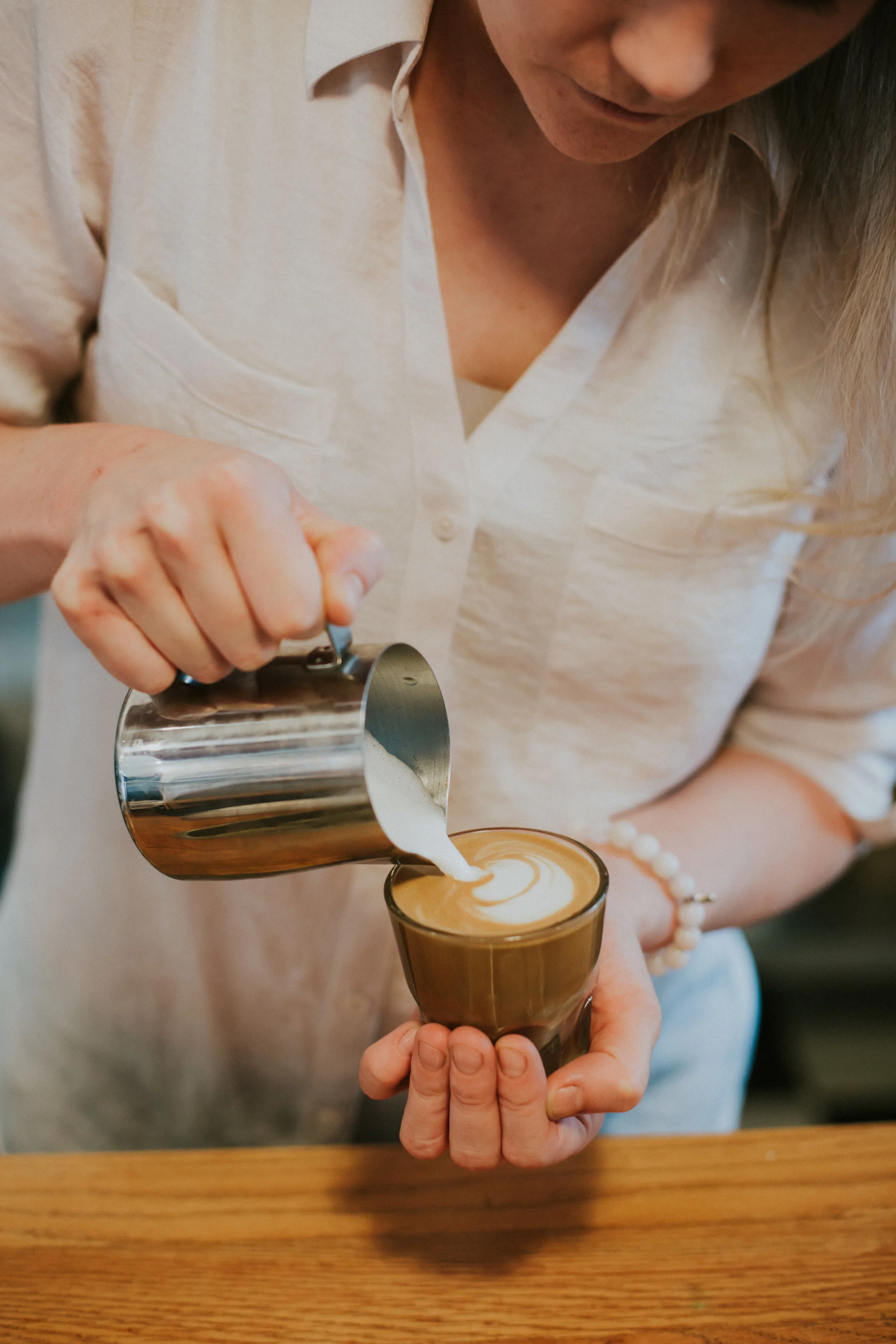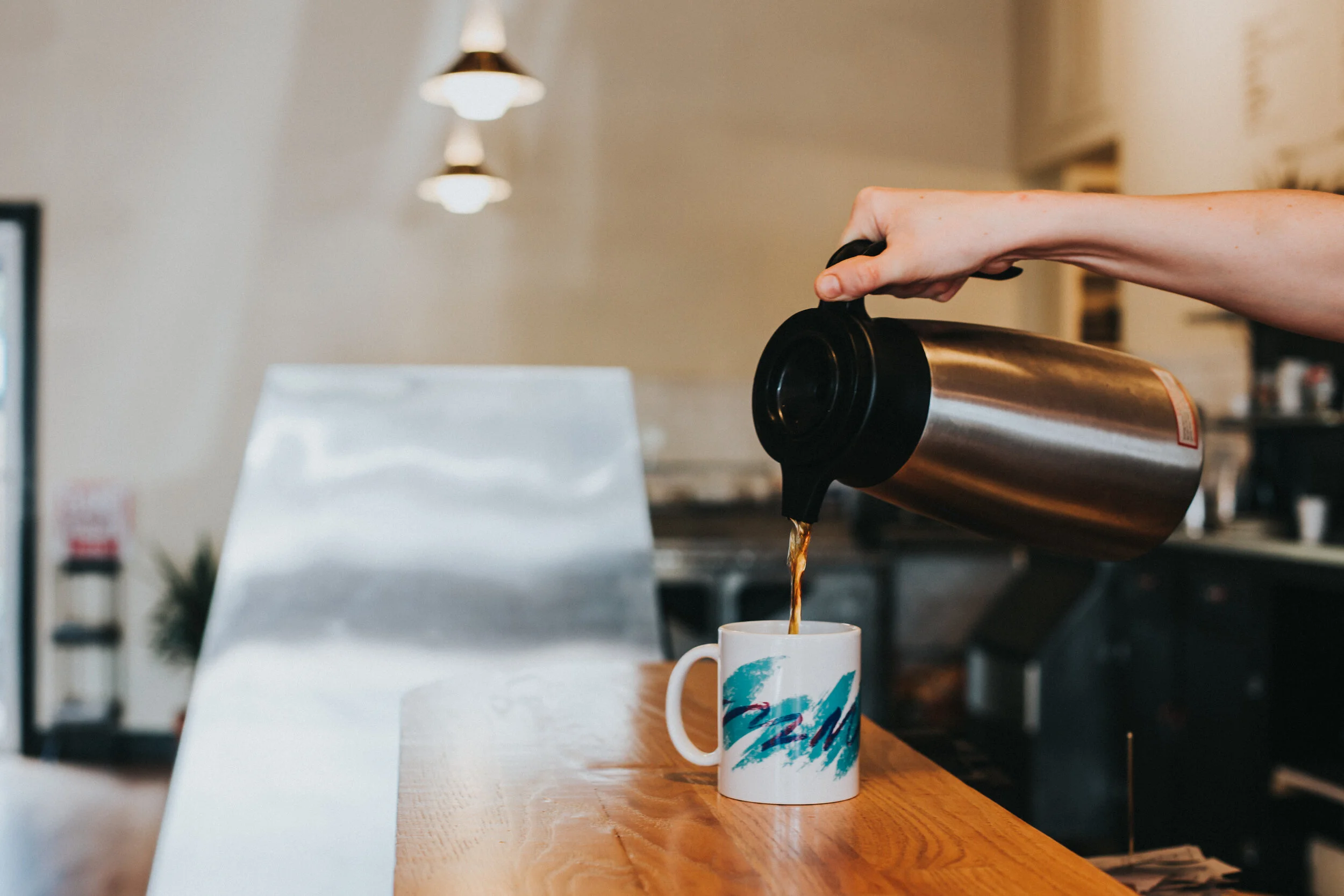Coffee 101: The where’s, how’s, and what’s of coffee drinking in downtown Greeley
To create fancy latte art, milk is shot with hot steam in a metal carafe to froth it. The goal is to get a thick foam with tiny bubbles with the consistency of wet paint. Photo courtesy of Margie’s Java Joint.
By Emily Kemme
Whether you’re an admitted coffee snob, or just someone who wants a solid cup of Joe before buckling down to work, there’s one thing all coffee lovers can be thankful for, and that’s goats. More specifically: the keen observations of a 9th century Ethiopian goat herder named Kaldi.
Coffee lore and legend spins it that Kaldi noticed how his typically frisky goats became even more energetic after nibbling cherry-colored berries off a tree. He shared this information with the abbot of a nearby monastery, who concocted a beverage from the berries, and discovered that the drink helped him stay awake during hours of evening prayer.
Over the centuries, word of this drink and the plant that produces it spread across Arabia by night owls and workaholics in equal measure.
By the 15th century, coffee was regularly cultivated and brewed in what is Yemen today. The coffee plant was brought to Persia, Egypt, Syria and Turkey, and by the 16th century, info about coffee came to Europe thanks to travelers’ stories about Near East coffee houses. By the early 17th century, a coffee bean trade was established in Venice, soon spreading to England, France, Germany and Holland. It was first brought to the American colonies in the mid-1600s.
Cultivation of coffee bushes remained centered in Arabia, but colonialism helped plant seedlings on the island of Java (held by the Dutch) which is today’s Indonesia, and the French made coffee inroads on Martinique. Those early plants parented coffee trees in the Caribbean, and South and Central America.
The three coffee-growing regions today
The coffee belt — located in Latin America, Africa and Arabia, straddles the Equator and aligns with the Tropic of Cancer and Tropic of Capricorn. This broad band where coffee is grown boasts rich soil, mild temperatures, and plentiful rain.
Inside the trees’ red fruit are coffee seeds (beans), that are raw and green. Two bean species dominate: robusta (light green, smaller and higher caffeine) and arabica (larger, greener beans with high acidity). Arabica beans with chocolatey, nutty notes hail from Latin America. Beans grown in Africa and Arabia are fruity and floral, and the Asian Pacific produces beans with a spicy, herbal profile: they can be either arabica or robusta.
A look at two different coffee shop styles in downtown Greeley
Now that you’re armed with some coffee basics, the NoCo Optimist checked in with two Greeley coffee shops to see how they brew, discover the most popular brew method, and learn about favorite local styles.
Founded by Linde and Ron Thompson in 1992, Margie’s Java Joint was named for Linde’s mom Margie. After a hiatus during which another coffee company was pulling the shots on the premises, these days the iconic coffee house is run by another Margie in the family — she’s called Margaret and is the Thompson’s daughter — and her husband Justin Ghofrani.
Beans: Margie’s serves Harbinger arabica beans sourced from Harbinger Coffee in Fort Collins. As single origin beans, they’re either 100% Guatemalan or Ethiopian; the espresso is a blend of 70% Guatemala and 30% Ethiopian beans.
The beans fall in the light to medium roast style, which Thompson said is counterintuitive. “The longer you roast it, the more caffeine you roast out of it.”
Pulling a shot: in coffee lingo, espresso is finely ground, gently tamped down in a filter, which is hitched onto an espresso machine (in Margie’s case it’s a La Marzocco Strata manual machine) from which a “shot” of espresso is extracted.
“The machine puts a ton of pressure on the puck (of grounds), and the water is pushed through at such high pressure that it extracts flavor out of the espresso, creating a liquified shot,” Thompson said.
At Margie’s, shots are calculated by weight rather than volume; all shots are 36 grams pulled in 36 seconds.
“Based on the time it takes to pull, we know if it’s pulling the shot too fast or too slow and can adjust the grind. If the grind is too fine, it’ll pull too slow; if too coarse, it pulls the shot too fast,” she explained.
It’s like pouring a watering can over a pot of rocks verses over a pot of sand, she said. The water will pour faster over the rocks and slower over the sand.
Why does time matter? It’s all about taste, Thompson said. The goal is a balance between the crema’s caramel sweetness and the brightness, or acidity, of the roast. If the extraction is over or under (too fast or too slow), your latte will have a bitter taste.
Crema v. Foam: Yes, there is a difference. Crema is the rich top layer of an espresso that has an oily consistency and a caramel taste. Foam is from milk, and it’s created after pulling the shot by shooting hot steam into a metal carafe of milk to froth it.
“Milk foam is really important for getting the fancy latte art, you have to get a thick foam with tiny bubbles with the consistency of wet paint,” Thompson said.
What’s popular?
When Margie’s reopened in 2018, Thompson said oat milk was taking the world by storm, and that hasn’t changed. Her shop serves it hot, iced, and as a chai or matcha latte with oat milk. Pour overs — boiling water poured over freshly ground beans — offer a wide variety of single origin beans from Harbinger, instead of being limited to the Guatemalan beans used for Margie’s drip coffee. If you’re into dark roasts with a chocolate-caramel flavor, that’s the one for you. For-here mugs in 12-and 16-ounce sizes get one free drip refill, likely why it’s developed a loyal following.
Aunt Helen’sHouse Coffee
Inspired by the Hutson family’s Great Aunt Helen, a “get to the point” kind of person, according to the shop’s website, it makes sense that the coffee aura at Aunt Helen’s Coffee House & Cafe and AH Express is about getting down to business. Helen Ingle, the coffeshop’s name sake, died last year
At Aunt Helen’s Coffee House and AH Express, the customer favorite is the Tall, Dark and Handsome, Aunt Helen’s version of a mocha. Photo courtesy of Aunt Helen’s Coffee House.
The shops use a Franke automatic espresso machine, which guarantees coffee quality. “The coffee is always the same, it doesn’t depend on a barista’s expertise,” owner Aimee Hutson said. Serving only espresso-based drinks and drip coffee, Hutson said the shop’s business model is to get customers in and out quickly. “We’re more of a businessman’s coffeehouse.”
Fair Trade beans: being quick doesn’t impact bean quality; Aunt Helen’s serves up a rotating medium roast called Cantalina with Ethiopian-sourced beans. Their dark roast (Bravaccio) is a robust blend of beans from Mexico, Indonesia and Honduras. Bravaccio is the house blend and is used for drip coffee, which Hutson describes as having notes of tobacco.
The shops buy through Coda, a local coffee roaster; Hutson said they were attracted to them because the roaster purchased former cocaine fields and replanted them with coffee. The products are also Fair Trade: the global movement pays United States wage rates to people in developing nations.
Customer fav’s: although the Hutsons’ preference is drip coffee because of its higher caffeine load, the shop’s Tall, Dark and Handsome latte (chocolate, vanilla, espresso) is popular with customers. It’s Aunt Helen’s version of a mocha. Second best is the Cat’s Pajamas, an iced caramel latte with caramel and vanilla syrups that’s guaranteed to have you purring.
Cuppings: to get a handle on what the taste of coffee is all about, Aunt Helen’s offers cuppings, opportunities to taste different brews and learn the history of coffee. The free cuppings are popular with businesses as team-building events, and Aims and University of Northern Colorado classes.
Health benefits of coffee: “There’s a lot of antioxidants in coffee, much like wine,” Aimee Hutson said. “Studies are showing that caffeine is better for you than originally thought, plus it makes everybody like each other better because people are happy when drinking coffee.”
Go get caffeinated (or not, decaf is okay, too):
Aunt Helen’s Coffee House
800 8th Ave., Ste 101 in Greeley| 970-324-9336 | ahutson@aunthelenscoffeehouse.com | Monday through Friday 7 a.m. to 4 p.m. | Saturday 8 a.m. to 4 p.m.
Aunt Helen’s Express
940 9th Ave. in Greeley | 970-301-4085 | aunthelensexpress@gmail.com | Monday through Friday 7 a.m. to 4 p.m. | Saturday 9 a.m. to 3 p.m.
Both Aunt Helen’s locations have extended hours during Downtown Greeley special events
Margie’s Java Joint
931 16th St. in Greeley | 970-451-5079 | hello@margiesjavajoint.com | Monday through Sunday 7 a.m. to 5 p.m.



